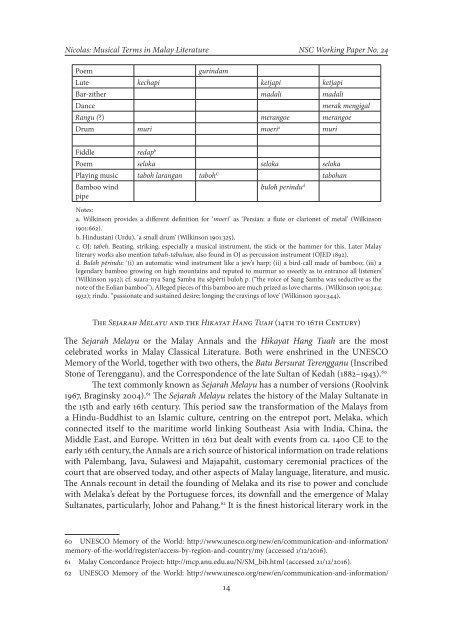2k2ADzp
2k2ADzp
2k2ADzp
You also want an ePaper? Increase the reach of your titles
YUMPU automatically turns print PDFs into web optimized ePapers that Google loves.
Nicolas: Musical Terms in Malay Literature NSC Working Paper No. 24<br />
Poem<br />
gurindam<br />
Lute kechapi ketjapi ketjapi<br />
Bar-zither madali madali<br />
Dance<br />
merak mengigal<br />
Rangu (?) merangoe merangoe<br />
Drum muri moeri a muri<br />
Fiddle<br />
redap b<br />
Poem seloka seloka seloka<br />
Playing music taboh larangan taboh C tabohan<br />
Bamboo wind<br />
pipe<br />
buloh perindu d<br />
Notes:<br />
a. Wilkinson provides a different definition for ‘moeri’ as ‘Persian: a flute or clarionet of metal’ (Wilkinson<br />
1901:662).<br />
b. Hindustani (Urdu), ‘a small drum’ (Wilkinson 1901:325).<br />
c. OJ: tabeh. Beating, striking, especially a musical instrument, the stick or the hammer for this. Later Malay<br />
literary works also mention tabuh-tabuhan, also found in OJ as percussion instrument (OJED 1892).<br />
d. Buloh pĕrindu: ‘(i) an automatic wind instrument like a jew’s harp; (ii) a bird-call made of bamboo; (iii) a<br />
legendary bamboo growing on high mountains and reputed to murmur so sweetly as to entrance all listeners’<br />
(Wilkinson 1932); cf. suara-nya Sang Samba itu sĕpĕrti buloh p. (“the voice of Sang Samba was seductive as the<br />
note of the Eolian bamboo”), Alleged pieces of this bamboo are much prized as love charms. (Wilkinson 1901:344;<br />
1932); rindu. “passionate and sustained desire; longing; the cravings of love’ (Wilkinson 1901:344).<br />
The Sejarah Melayu and the Hikayat Hang Tuah (14th to 16th Century)<br />
The Sejarah Melayu or the Malay Annals and the Hikayat Hang Tuah are the most<br />
celebrated works in Malay Classical Literature. Both were enshrined in the UNESCO<br />
Memory of the World, together with two others, the Batu Bersurat Terengganu (Inscribed<br />
Stone of Terengganu), and the Correspondence of the late Sultan of Kedah (1882–1943). 60<br />
The text commonly known as Sejarah Melayu has a number of versions (Roolvink<br />
1967, Braginsky 2004). 61 The Sejarah Melayu relates the history of the Malay Sultanate in<br />
the 15th and early 16th century. This period saw the transformation of the Malays from<br />
a Hindu-Buddhist to an Islamic culture, centring on the entrepot port, Melaka, which<br />
connected itself to the maritime world linking Southeast Asia with India, China, the<br />
Middle East, and Europe. Written in 1612 but dealt with events from ca. 1400 CE to the<br />
early 16th century, the Annals are a rich source of historical information on trade relations<br />
with Palembang, Java, Sulawesi and Majapahit, customary ceremonial practices of the<br />
court that are observed today, and other aspects of Malay language, literature, and music.<br />
The Annals recount in detail the founding of Melaka and its rise to power and conclude<br />
with Melaka’s defeat by the Portuguese forces, its downfall and the emergence of Malay<br />
Sultanates, particularly, Johor and Pahang. 62 It is the finest historical literary work in the<br />
60 UNESCO Memory of the World: http://www.unesco.org/new/en/communication-and-information/<br />
memory-of-the-world/register/access-by-region-and-country/my (accessed 1/12/2016).<br />
61 Malay Concordance Project: http://mcp.anu.edu.au/N/SM_bib.html (accessed 21/12/2016).<br />
62 UNESCO Memory of the World: http://www.unesco.org/new/en/communication-and-information/<br />
14


